Furniture may now be constructed from various materials, including plastic, metal, wicker, and timber. Timber furniture is a product that is made particularly using timber as a raw material. Timber’s prominent characteristics in furniture building are its longevity, toughness, hardness, and stiffness.
There’s no denying that wood can dramatically change the tone of a room or even a whole home. The use of wood furniture produces a feeling of warmth and elegance – an inviting atmosphere. Of course, putting wooden furniture in houses and other structures is not a new concept; timber has been used for furniture creation for decades; in fact, timber was one of the earliest building materials utilised by man. It provides a level of perfection that just cannot be matched.
This post will go over some of the benefits of utilising timber furniture in your home or workplace, as well as how to remove dirt off wood furniture and maintenance suggestions to keep wood furniture pieces looking fresh.
Advantages Of Choosing Timber Furniture
The following are just a few of the benefits of having timber furniture in your home or office:
1. Strength And Durability
Timber furniture is very durable and requires minimal maintenance, which is two of the primary reasons why many people pick it for their house. So, if you want your furniture to be simple to maintain and last a long time, you can’t go wrong with solid, stylish wood. Because of the longevity of wood furniture, you receive good value for money because your furniture will preserve its worth for many years.
2. Easy Maintenance
Timber is easy to maintain. Timber furniture is simple to maintain due to its longevity. The simple procedure of waxing, polishing, and oiling should only be done on a regular basis. Typically, all that is necessary to keep wood furniture in good condition is a quick wipe down with a moist cloth.
3. Versatility
The majority of individuals feel that wood looks great in practically any scenario. Wooden furniture may be utilised in any design scheme, whether it is rustic or contemporary. Its adaptability extends to outdoor settings as well. Timber furniture, such as treated pine and jarrah, may look stunning on a porch or in a garden setting.
4. Elegant Appearance And Feeling
Wood provides warmth, charm, and dignity to every room in any house, whether it’s a lighter-coloured wood or one with deep, dark colours. And when the same piece of wood is created by a talented craftsman, it has endless potential to add beauty to any piece of furniture. For city dwellers who live in high-density apartment buildings, hardwood furniture is the only way to bring nature inside. In any antiseptic environment, wood elicits an instant sense of warmth and comfort.
5. Modifiable
Timber furniture may be updated repeatedly throughout time. It may be restored to offer a totally new and unique style to fit any area in your house using easy methods such as painting and staining.
The benefits of having hardwood furniture in your house are described by adjectives such as strength, elegance, and appeal, as well as beauty and appearance. The practical benefits of having wooden furniture are its strength, adaptability, and lifespan.
How To Clean Old Timber Furniture?
Every collector should understand how to clean antique timber furniture to reduce unnecessary errors. When you know how to clean antique wood furniture properly, you may prevent irreversible damage and affect the value of your purchases.
Use oil soap and warm water to eliminate debris and dust. Two 100% cotton rags or clothes will be needed. The first towel is for cleaning, and the second is for drying. You may need multiple clothes or rags for bigger pieces of furniture.
Supplies Required
- Soap made from oil
- Two cotton rags/clothes
- A small bowl
- Measuring cup
- Spoon (to mix water and oil soap)
- Gloves made of rubber (optional)
Instructions
- Put on some rubber gloves.
- Pour six ounces of water into one ounce of oil soap.
- Using a fork, combine all the ingredients.
- Press a dry, soft cloth into the basin.
- Wring out the excess water/soap combination from the cloth.
- Small circular strokes with the soapy cloth following the grain of the wood are recommended.
- Following the grain of the wood, work your way along the length of the furniture.
- After you’ve worked the wood surface, wipe away any excess moisture with a dry towel.
- Gently massage the wood in tiny circular strokes to remove any remaining moisture.
- If the wood is wet after you’ve gone over it, use a new, dry towel to remove any lingering moisture.
You may either leave your furniture as it was freshly washed or apply furniture wax to preserve it. After you’ve waxed the furniture, use a soft cloth to buff it by rubbing in tiny circular movements along the wood grain.
When dealing with chemicals that might enter your airways, lungs, or eyes, you should use goggles and an air mask. This is particularly true when removing mildew from antique wood furniture. Mildew may be removed with dish soap and warm water. Mildew killers, such as distilled white vinegar, may be required for more resistant mildew.
Mineral spirits may be used to clean certain wood antiques. Mineral spirits should be used cautiously since they may ruin certain materials. Before beginning any antique cleaning, doing a spot test is usually a good idea.
Conclusion
Wooden furniture’s timeless look and appeal, with its many tones and textures, provide character and warmth to any area in any home. With the correct expertise and equipment, hardwood furniture may be restored or mended even if it is old and ruined. Timber furniture, without a doubt, provides a feeling of refinement and warmth to any house.















